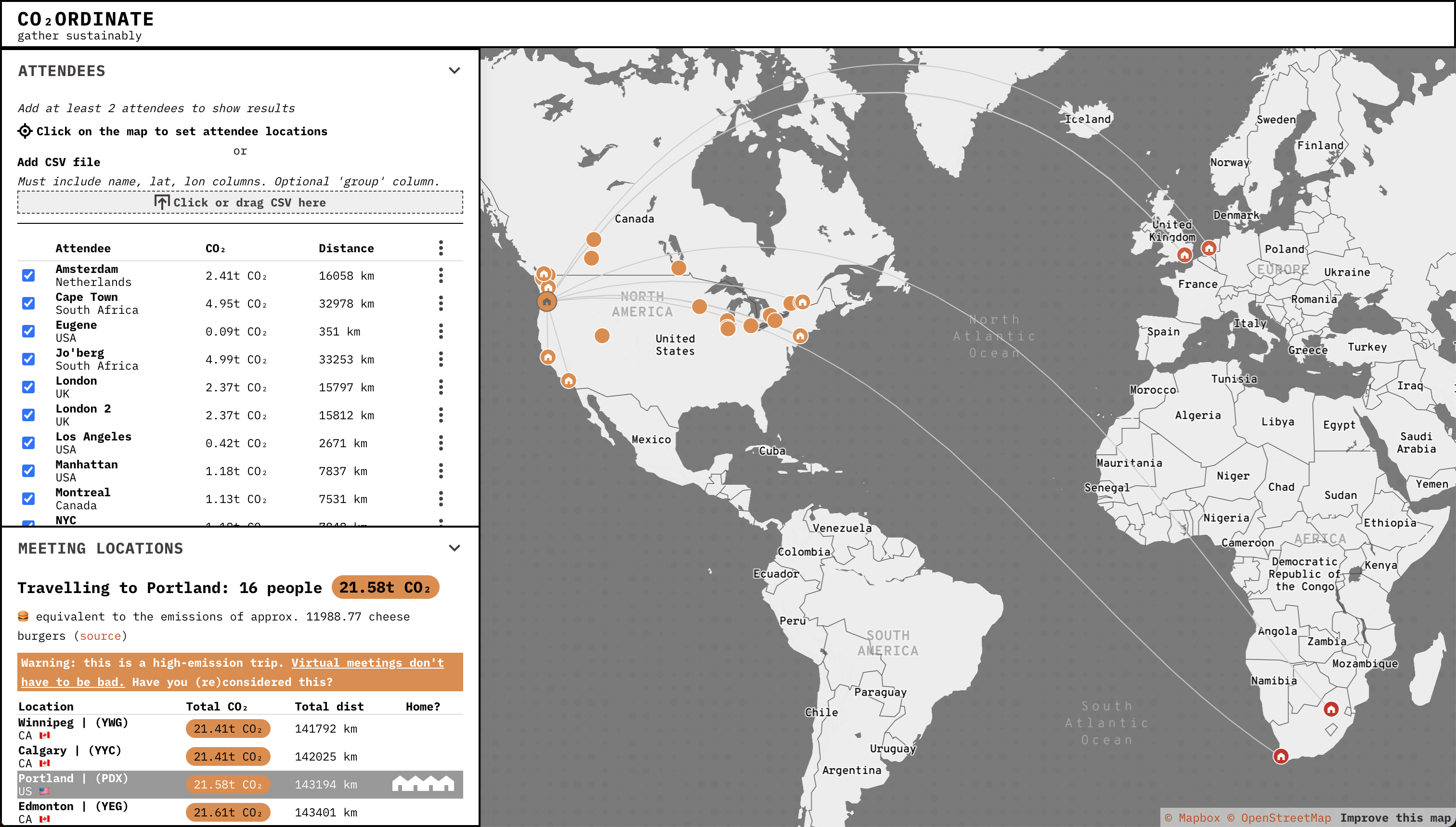Co₂ordinate helps distributed teams and conference organizers find the most CO₂ efficient place to meet.
Consider this: if you travel from London to New York (and back) in economy class, you will emit about 2 tons of CO₂ emissions. This is equivalent to a whole year of emissions for the average Indian national or roughly 50 days for the average US resident.
We will lose our ability to inhabit this planet soon if we don't drastically change our habits. Per kilometer, flying is the most carbon-intensive mode of transportation. Optimizing our travel patterns is necessary to reduce our CO₂ footprint. We built Co₂ordinate to help distributed teams and conference organizers find the most CO₂ efficient place to meet.
Flying is the most carbon intensive means of transportation per kilometer.
Air Travel’s Carbon Reality
Many collective, individual and policy actions are needed to avert the climate crisis. Flying has become especially scrutinized in recent years, and for good reason. You could theoretically circumnavigate Earth 8 times by train (electric, powered by a renewable grid) for the same amount of greenhouse gas (GHG) emitted.
To ensure our planet's temperature doesn't increase by more than 2 degrees, every person should restrict their emissions to 2.3 tons of CO₂ annually. For frequent flyers, flying will be a large share of their GHG emissions. Traveling internationally offers cross-cultural experiences, life-changing opportunities, and career opportunities. It’s unrealistic to expect that air travel will completely stop.
Carbon Choices of a Global Team
We are a remote-first company bringing together a global team to build geospatial solutions and global insights for a complex and changing planet.
While we communicate virtually and asynchronously daily, we fully understand the benefits of meeting in person. After three years of delaying our annual team meeting due to COVID-19, we had a truly energizing meeting this year. Being a distributed team spread across 5 continents means flying will always be part of our professional lives.
It was impossible not to be aware of the emissions associated with this gathering. We needed a GHG-conscious way to optimize how we pick the place for our team members to meet - an interesting geospatial challenge!
Fly Smart with Co₂ordinate
Co₂ordinate was created as an internal tool to organize our Team Week and future team gatherings. It allows you to select which team members need to meet, and Co₂ordinate will rank the most efficient places to gather. This ranking is based on locations with fewer flight-related GHG emissions for a group of team members. The selection is geared towards places close to at least one team member.
Ultimately, you'll have to decide based on other factors (economics, attractions available in a city, GHG emissions from staying there, public transport availability, etc. ); this tool is not a complete travel planner.
We think this could be useful beyond our team, so we are putting it out for everyone to use (source on Github).
Co₂ordinate allows adding team members by either dragging and dropping a CSV file, or manually picking team members’ locations on the map. After selecting which of these team members need to meet, the tool will compute a ranking of the places that entail less flight-related GHG emissions. The selection offers a bias towards places that are close to at least one team member's home region.
Users can click to add people by location and group and also upload a .csv.
Balancing Carbon & Connection
The goal of this tool is primarily awareness - the best flight is the flight you don’t take. We hope this tool will primarily lead to questioning whether a meeting is necessary and encourage exploring alternatives.
Calculating precise GHG emissions from flights is not an easy task - aircraft type, routing, weather conditions, payload, seating class, and many other factors have to be considered. Our approach is explicitly “low-resolution.” It gives orders of magnitude rather than precise estimates. This helps us balance the post-COVID thirst for in-person meetings and air travel's huge impact. Based on some limited testing, Co₂ordinate’s CO₂e estimates are 100-270% of Google Flights.
We’ve been using Co₂ordinate to plan other internal team meetings for the past year. Co₂ordinate has helped us narrow down meeting locations to the most CO₂e-efficient ones. Final locations are decided by evaluating additional factors, including cost, co-working spaces, and accommodation.
Groups can be included or excluded from analysis without having to delete them.
Co₂ordinate’s Core
The core of Co₂ordinate is an algorithm that will go through all worldwide major airports (using the OurAirports database), compute CO₂eq estimates for each participant-airport pair, and sort results based on the cumulative emissions for each round trip to each airport. Distances are approximated using the circle distance (Haversine formula), applying a factor depending on the flight distance (long haul/short haul/domestic) based on the methodology described in this article.
The app is built in React and was initially set up to work in our intranet using our UI library.
Next Stops for Co₂ordinate
The current version of Co₂ordinate is anchored on a simple premise: CO₂ emissions estimation based on flight distances. While effective in its own right, this method has room for improvement. Our estimates are consistently higher than commercial flight planners, and the discrepancies are sometimes pretty significant.
Perhaps the most significant oversight in our current model is its inability to factor in layovers. As frequent flyers will attest, layovers can prolong our journey and significantly influence CO₂ emissions. Where does this lead us? We’d love to incorporate a more nuanced GHG emissions calculation methodology. And, taking a cue from our travel-savvy users, ensure layovers and flight routes find their rightful place in our calculations.
The primary challenge is data access. Commercial APIs are a tempting source, but we're eager to craft a solution rooted in open data. Maybe even building our own routing logic. Beyond accuracy, we have a bunch of exciting features in the backlog, including train travel as an alternative when applicable, a destination-centric view, rendering emissions isochrones on the map, including a “city sustainability index,” allowing for split destinations (meeting in multiple places to optimize emissions), etc.
We’re interested in your feedback on this project, and if you want to incorporate this tool into your company or conference, reach out; we’d love to talk.
What we're doing.
Latest



